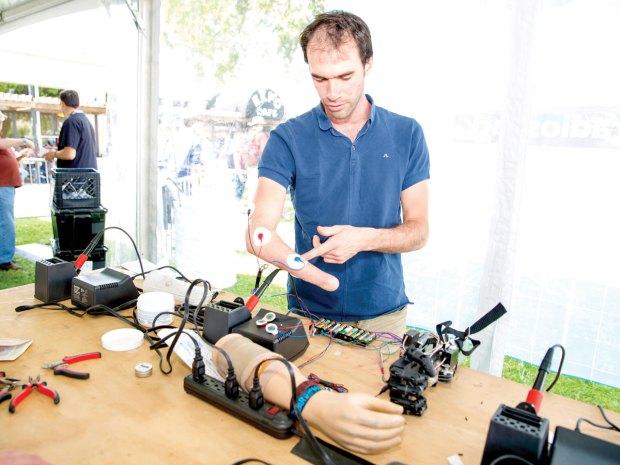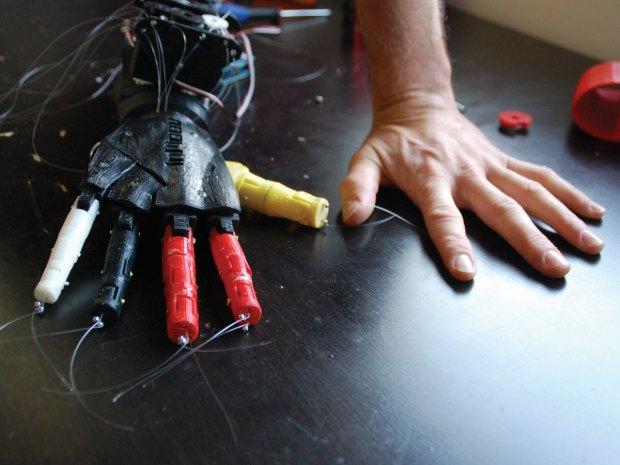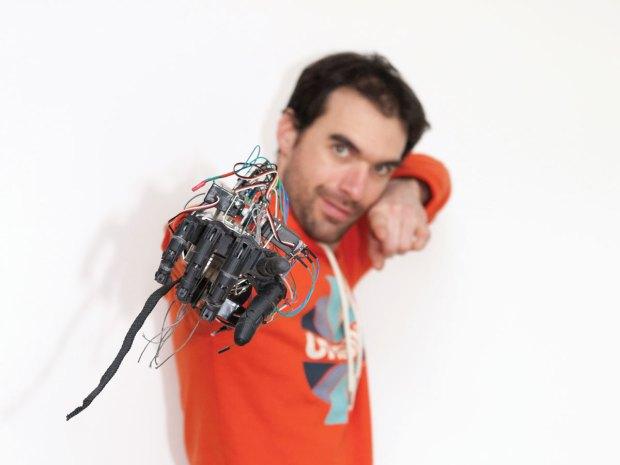We love how the maker spirit has inspired a sense of global community, particularly when it involves improving quality of life in some pretty dramatic ways. One remarkable story about how the growing open source culture and 3D printing have changed lives comes from the French city of Rennes, a few hours east of Paris. Rennes native Nicolas Huchet’s accident with a hydraulic press twelve years ago left him without a right hand. Since then, Huchet, who told his story on the webzine Make:, has experienced the frustration of finding a prosthesis that gives him capabilities beyond rudimentary functions.
Huchet is young and active. He’s an audio specialist, including teaching Pro Tools, the industry-favored software for digital audio production. He’s also a musician. He hasn’t let the accident deter him from living a full life. However, his experiences with prosthetic devices left him extremely frustrated, particularly for other amputees who couldn’t afford the higher-tech myoprostheses — limb replacements that the user can control with muscle sensors.
“There are new models,” says Huchet, “but they are very expensive. I tried them all… but even $50,000 models were lacking.”
Furthermore, he found that his health insurance often didn’t cover the more extensively functioning prosthetic devices, so he and people like him without such resources were forced to accept a quality of life that was less than it might be.
Huchet, dissatisfied with accepting less, began doing research. He found that even the more expensive prosthetic devices were not necessarily the most functional ones and that you paid dearly for aesthetics. As his quest continued, the determined young Frenchman made a list of his requirements: The prosthesis had to be durable and reasonably lightweight. It needed to have an opposable thumb. It would have to be able to reach a maximum opening size “at least large enough to grab a coffee cup or a water bottle,” but it would have to close “precisely enough to hold a coin, a pen, or the cable to your headphones.” It must grasp in a neutral position rather than pinching in a palm-down position.

Photo credit: Miguel Templon
Those requirements may seem minimal, but Huchet’s research proved they were not a given for prosthesis manufacturers. As he looked further, he stumbled upon viable alternatives. He explained, “Alternative prosthetics — many 3D-printed, articulated, and open-source — built at universities, fab labs, and even companies, are beginning to fill the gaps.” He didn’t know much about 3D printing and didn’t really know where to begin in terms of finding a source for a 3D printed prosthesis, much less making one himself.
That all changed in October 2012, however, when Huchet happened upon a 3D printing exhibition in Rennes. He asked someone involved in the exhibition if it was possible to make a robotic hand using 3D printed and the affirmative reply set him immediately on a new path. One of the people with whom he spoke told him it was possible to download a robotic hand on Thingiverse. Huchet was told that the pieces for the prosthetic hand could actually be produced using a 3D printer. The people at the exhibition shared more information with him and, he recalls, although he didn’t really understand what they were talking about at the time, he “knew what they meant: It’s possible to design an inexpensive bionic hand that you can make yourself, then share your work so other people can improve it and share it further.”
A few months later, in February 2013, the evidently inexhaustible Huchet launched his own project with the help of the LabFab in Rennes. The project was “a truly international effort,” however, as it involved 3D printing the digits for the hand in Rennes, acquiring the muscle sensors from the US, and getting input for the overall design from a source in Brazil. His first decidedly low-tech, 3D printed prototype, a collaboration with Gael Langevin, who created the 3D printed prosthetic device, InMoov, used some fishing line and an old NesQuik box. After that, the pace quickened and Huchet found himself at the first European Maker Faire in Rome, Italy, where he learned how to actually use a 3D printer and afterwards improved his own prototype. From Rome he found his way to the Geek Picnic in St. Petersburg, Russia and then on to New York for the World Maker Faire.

Photo credit: Jeffrey Braverman
Since that early prototype, he’s refined his myoprosthesis, which he refers to as “a device for which there is a great need. In the United States,” Huchet elaborates, “insurance may pay for a prosthesis. In Colombia, they give you a hook; and in Russia, not much else.” He concluded that, around the world, options were pretty dismal for people who couldn’t afford to pay for more than rudimentary prostheses.
Huchet’s myoprosthesis, which he calls, “Bionico,” is still a work in progress. It cost him about $250 to make, so it’s absolutely budget-friendly, and that’s huge. He’s considering starting a crowd funding campaign to further the project, looking for sponsors for what he terms his “philosophy of a utopia of health for everyone.” He aspires to create a worldwide network, including a database, that is devoted to improving and creating new, more high-functioning prosthetic devices. Huchet’s website, bionico.org, provides information about where he is in the process and how makers and 3Ders around the world can be of help.
What do you think of Huchet’s efforts in the prosthetics arena? Let us know your opinions on the viability of the Bionico hand over in the Bionico Robotic Prosthetic Hand forum thread at 3DPB.com.
[Source: Make:zine]Subscribe to Our Email Newsletter
Stay up-to-date on all the latest news from the 3D printing industry and receive information and offers from third party vendors.
You May Also Like
3D Printing Financials: Fathom Struggles in Financial Quicksand During Critical Transition
Facing a year of key transitions and financial pressures, Fathom (Nasdaq: FTHM) has filed its annual report for 2023 with the U.S. Securities and Exchange Commission (SEC). The document outlines...
Latest Earnings Overview for Australian 3D Printing Firms Titomic and AML3D
Australian 3D printing manufacturing firms Titomic (ASX: TTT) and AML3D (ASX: AL3) reported their financial results for the period from July to December 2023, marking the first half of their...
3D Printing Webinar and Event Roundup: April 7, 2024
Webinars and events in the 3D printing industry are picking back up this week! Sea-Air-Space is coming to Maryland, and SAE International is sponsoring a 3D Systems webinar about 3D...
3D Printing Financials: Unpacking Farsoon and BLT’s 2023 Performance
In the Chinese 3D printing industry, two companies, Farsoon (SHA: 688433) and Bright Laser Technologies, or BLT (SHA: 688333), have recently unveiled their full-year earnings for 2023. Farsoon reported increases...

































